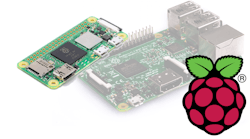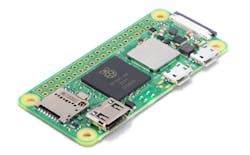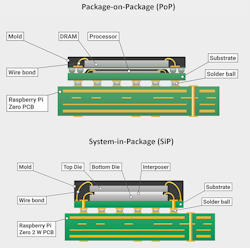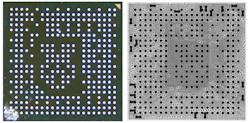Raspberry Pi Zero 2 W Built for Compact Designs
This article is part of TechXchange: Raspberry Pi
The Raspberry Pi has spawned a host of related platforms and form factors. And the beat continues with the Raspberry Pi Zero 2 W (Fig. 1). That mouthful is built around a 1-GHz, quad-core, 64-bit Arm Cortex-A53 processor with 512 MB of SDRAM. It supports Bluetooth 4.2 and BLE as well as 2.4-GHz Wi-Fi 802.11b/g/n. Its tiny 65- × 30-mm form factor has space for a 40-pin header, a microSD card adapter, a CSI-2 camera connector, a Mini HDMI port, and a USB 2.0 OTG interface.
The original Raspberry Pi Zero used a BCM2835 in a package-on-package (PoP) solution to keep the size down, while this latest incarnation employs a RP3A0 system-in-package (SiP) that stacks the BCM2710A1 die with a 4-Gb Micron LPDDR2 die (Fig. 2). The printed circuit board (PCB) also utilizes extra-thick copper layers as a heatsink; thus, the faster chip does away with a heatsink or active cooling.
The wireless support is contained within a metal shield can. Having the wireless support built-in means the module can be used without additional FCC certification. Not bad for a $15 module if you can get your hands on one. Even the Raspberry Pi isn’t immune to the global semiconductor shortage.
As with most module solutions, the form factor lends itself to embedded applications where a custom design isn’t warranted due to the estimated number of products being sold. It still keeps the overall form factor down and uses a platform that was likely used to develop the application. This limits the alterations that are needed with a platform change, which is often required when considering migration of a Raspberry Pi solution to a custom implementation.
In closing, the designer, Simon Martin, hides the Raspberry Pi logo using the ball-out of the chip itself (Fig. 3).




